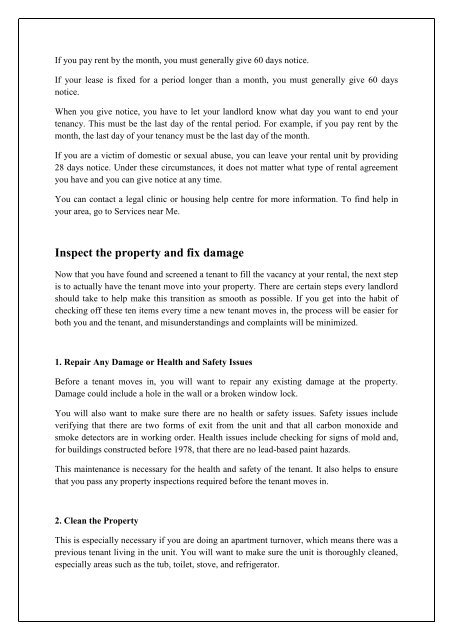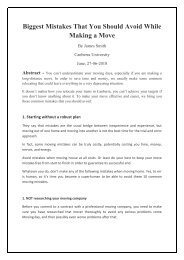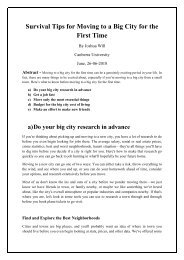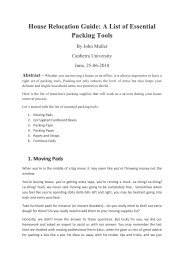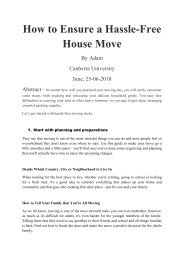What to do when moving out of a rental property tenant move out checklist
Create successful ePaper yourself
Turn your PDF publications into a flip-book with our unique Google optimized e-Paper software.
If you pay rent by the month, you must generally give 60 days notice.<br />
If your lease is fixed for a period longer than a month, you must generally give 60 days<br />
notice.<br />
When you give notice, you have <strong>to</strong> let your landlord know what day you want <strong>to</strong> end your<br />
tenancy. This must be the last day <strong>of</strong> the <strong>rental</strong> period. For example, if you pay rent by the<br />
month, the last day <strong>of</strong> your tenancy must be the last day <strong>of</strong> the month.<br />
If you are a victim <strong>of</strong> <strong>do</strong>mestic or sexual abuse, you can leave your <strong>rental</strong> unit by providing<br />
28 days notice. Under these circumstances, it <strong>do</strong>es not matter what type <strong>of</strong> <strong>rental</strong> agreement<br />
you have and you can give notice at any time.<br />
You can contact a legal clinic or housing help centre for more information. To find help in<br />
your area, go <strong>to</strong> Services near Me.<br />
Inspect the <strong>property</strong> and fix damage<br />
Now that you have found and screened a <strong>tenant</strong> <strong>to</strong> fill the vacancy at your <strong>rental</strong>, the next step<br />
is <strong>to</strong> actually have the <strong>tenant</strong> <strong>move</strong> in<strong>to</strong> your <strong>property</strong>. There are certain steps every landlord<br />
should take <strong>to</strong> help make this transition as smooth as possible. If you get in<strong>to</strong> the habit <strong>of</strong><br />
checking <strong>of</strong>f these ten items every time a new <strong>tenant</strong> <strong>move</strong>s in, the process will be easier for<br />
both you and the <strong>tenant</strong>, and misunderstandings and complaints will be minimized.<br />
1. Repair Any Damage or Health and Safety Issues<br />
Before a <strong>tenant</strong> <strong>move</strong>s in, you will want <strong>to</strong> repair any existing damage at the <strong>property</strong>.<br />
Damage could include a hole in the wall or a broken win<strong>do</strong>w lock.<br />
You will also want <strong>to</strong> make sure there are no health or safety issues. Safety issues include<br />
verifying that there are two forms <strong>of</strong> exit from the unit and that all carbon monoxide and<br />
smoke detec<strong>to</strong>rs are in working order. Health issues include checking for signs <strong>of</strong> mold and,<br />
for buildings constructed before 1978, that there are no lead-based paint hazards.<br />
This maintenance is necessary for the health and safety <strong>of</strong> the <strong>tenant</strong>. It also helps <strong>to</strong> ensure<br />
that you pass any <strong>property</strong> inspections required before the <strong>tenant</strong> <strong>move</strong>s in.<br />
2. Clean the Property<br />
This is especially necessary if you are <strong>do</strong>ing an apartment turnover, which means there was a<br />
previous <strong>tenant</strong> living in the unit. You will want <strong>to</strong> make sure the unit is thoroughly cleaned,<br />
especially areas such as the tub, <strong>to</strong>ilet, s<strong>to</strong>ve, and refrigera<strong>to</strong>r.


